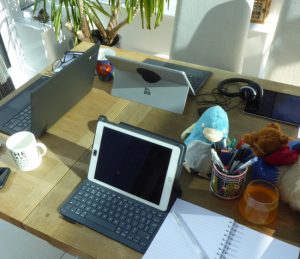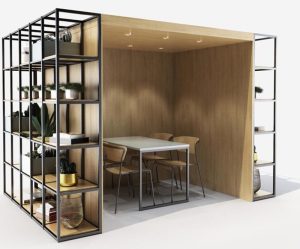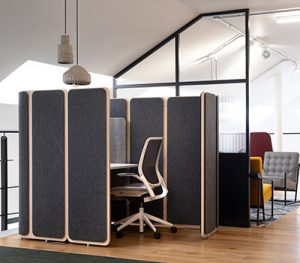This is the third in a series of 5 blogs exploring key considerations for employers who are establishing their post-pandemic arrangements for knowledge workers. Click here for the first in the series.
We have talked about the core behaviours of working – the 4Cs – for many years. They are Communication, Collaboration, Concentration and Contemplation.
The rush to homeworking as a result of the pandemic has really highlighted which of the 4Cs work best away from the office. As growing numbers of people reported increased productivity at home, it became clear that focused work – Concentration and Contemplation – saw the greatest benefit. This ability to just get things done without distraction has been one of the standout discoveries of the last fifteen months.
 It is important to remember, though, that this may not apply to everyone. Leesman research shows a significant difference in experience between those with a dedicated home office or study and those working in areas not designed for work. Clearly, being able to shut the door on others in the house is very different from working at the dining table or in shared space with flatmates.
It is important to remember, though, that this may not apply to everyone. Leesman research shows a significant difference in experience between those with a dedicated home office or study and those working in areas not designed for work. Clearly, being able to shut the door on others in the house is very different from working at the dining table or in shared space with flatmates.
Personality and the nature of work activities are other factors which impact people differently. Whatever their domestic circumstances, there will be those who crave face-to-face interactions with colleagues. There will also be those who are happy to avoid them but should probably be strongly encouraged to seek them out!

Dutch architect, Stephanie Akkaoui Hughes talks of the importance of interactions, saying that your ‘space is a strategic tool’ which should be a catalyst, an active enabler to facilitate those interactions. This brings us to a fifth ‘C – Creativity. Many organisations are reporting anecdotal evidence of loss of creativity as a result of homeworking and we must remember that this is not a subject that applies exclusively to marketing or design. It applies just as much to engineers and coders. Creativity is central to all our work and some of the best creativity comes in circumstances of collaboration.
On the subject of serendipitous encounters, there is also growing anecdotal evidence that training and education is suffering because newer and younger employees are missing out on the osmosis learning they pick up from more knowledgeable and experienced colleagues. This has potentially significant long term risks of detrimental impact on the business and may be one of the strongest reasons to think very carefully before abandoning the office altogether.

This is your perfect opportunity to create a Magnetic Office – one that attracts your people back, one that supports your culture, fosters interactions and enhances productivity. Don’t waste that opportunity!
Click here for the next blog in the series.